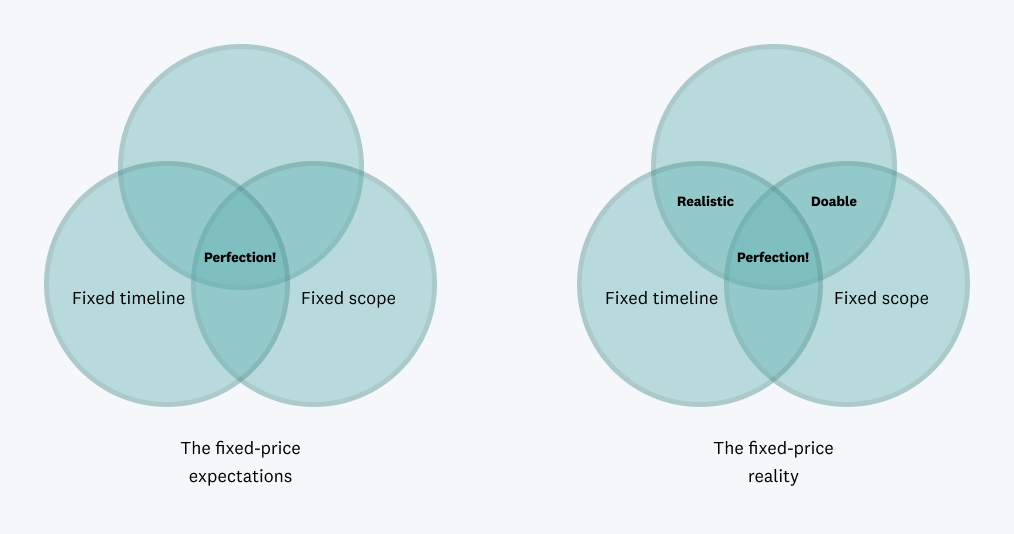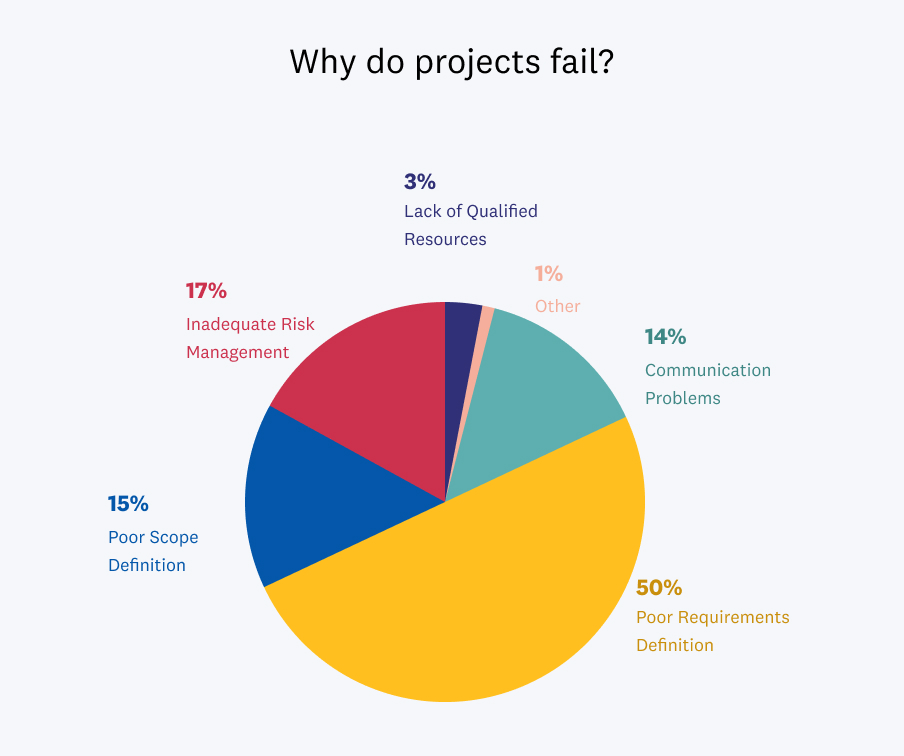Tuesday, Sep 5, 2023

Software Development Pricing Models: Fixed-Price vs. Time and Materials
Software development is a complex process including not just coding, but also other crucial steps like business analysis, roadmap setting, design, testing, support and maintenance.
Because of its complexity, because of the expertise and the skills needed for each of these steps, software projects can be quite expensive.
While there are ways to reduce the costs, you should never put price over value, as you risk the quality and the ultimate success of your project.
An additional segment of starting a software development project is choosing the appropriate type of price contract. -+Pricing models largely differ depending on your project type and size, as well as your project documentation, specifications and requirements.
This is why we have prepared a guide that will lead you in choosing the one pricing model that fits your needs and your project in the most feasible way.
When you are starting with a new software development project, you should first be aware of all the factors that have an impact on its final cost.
If this is your first such project, you may find yourself baffled by the cost estimate you receive from your software development partner company. This, however, will not be the case if you get yourself familiar with the entire development process, as well as with the ensuing support and maintenance costs.

You need to know your project well. What type of a project do you have? What is the size of your project? What technologies will the project require for development?
You also need to know your team well. How many people will the project development require? How experienced do they need to be? Which roles will be required? Where do I wish to outsource my work to?
All of this significantly impacts the final cost.
Along with price estimates, you will have to get familiar with the different pricing models.
In the world of software development, there are two main pricing models you will encounter:
- A fixed-price (FP) model
- A time and materials (T&M) model
Each of these models comes with its own set of advantages and disadvantages. Knowing these will help you make an informed decision, stay within your budget and have a software product of optimal quality.
What is a Fixed-price contract?
With a fixed-price model, the budget, project specifications and the final deadline are all predefined and fixed, meaning none can change throughout the development process.
It is clear that, with this model, the client needs to extensively plan ahead to be able to deliver detailed instructions their development provider can follow. Planning, to the very last bit and detail, is crucial to make this model a success story, especially due to the fact that the client hands over the control of the project and is not involved in its development.
In order to successfully stay within the fixed project budget, the overall scope of work will need to be clearly defined. Another important factor is setting project milestones which will allow the client, along with the development team, to easily track the progress and the ongoing success of the project, as well as whether the project will be able to reach the final deadline.
While this may seem like a good way to stay in control of both the budget and the project timeline, not having to deal with prolonged delivery or hidden development costs, this model doesn’t leave a lot of room for creativity, change and optimization, trends and user feedback adjustments.
Pros of a FP contract
A fixed-price contract offers a certain level of security for the client company:
- No hidden costs. After signing the contract, there can be no more changes to the final cost of the project. The partner software development company cannot introduce any hidden charges nor can they add anything to the cost without prior notice and agreement.
- Monitor progress. Tracking progress is easy when you have a clearly defined set of smaller project milestones and the final project deadline. The client, although not in charge of development, monitors the progress and can act if it is not on track with the given timeline.
- Initial ideas. The development team follows the technical and business specifications and requirements which were planned ahead, ensuring that the final product is a clear representation of the initial client ideas and plans.
Cons of a FP contract
As the development process is complicated, the tech world constantly moves and progresses, there are certain aspects no one can predict. In a fixed-price cooperation, all of the possible changes that occur throughout the project development, present a major issue. This model also leaves no room for risk management, all of which can make cooperation difficult.
- No room for changes. Every new addition to the project scope presented by the client first needs to be negotiated, agreed and signed upon for the project to continue in the new direction. This will inevitably change the initial project deadline, and, with extra hours, most probably affect the budget as well.
- Blocking creativity. Any creativity and innovation coming from the side of the software development team will be obstructed as the project is operating under very strict instructions, which means there would be no time, nor budget, to implement the proposed features or ideas.
- Strict deadlines. Working under strict deadlines that are not prone to change, the developers may risk the quality of their code. Not everything can be planned and predicted before development starts, and, if anything unexpected occurs, the quality of the code and the final product will likely suffer the most, since the team’s goal will be to stay within the given deadline and the budget. This could also put a strain on the testing phase, if there is not enough time to conduct thorough QA.
- No client involvement. The client is not involved in the process, does not manage the team and does not give any additional instructions to the ones given at the beginning, which is why poor planning comes at a major cost. If the client didn’t specify the requirements and documentation to the necessary level of understanding, the final product may not be what the client originally intended, or desired it to be.
Another problematic aspect of this model is that it is extremely difficult to plan everything ahead of time. Numerous problems may arise during the development phase: the feature you wanted may be impossible or very time-consuming to implement, some features need to be expanded or altered, the feature did not turn out the way you imagined it would, not to mention problems related to your user satisfaction and feedback, as well as changes in the market.
You cannot predict everything, nor can you control it.

When to choose a FP contract
To make sure that these disadvantages do not overshadow the possible advantages, make sure you choose this contract in a scenario in which it can be beneficial for you and your project:
- A small and short-termed project, not lasting more than two months.
- Building an MVP.
- You do not wish to be involved in the project and prefer to negotiate everything in advance.
- You will not make or agree to any changes to the project as it develops.
- You are positive that the project requirements will not change in any way. All the necessary documentation is worked out and prepared, including the technical specifications (SRS), a well-developed project development plan and strategy, as well as workflows, wireframes, user journey maps, and user stories.
- You have a sample project you wish to send to the potential software development partner to analyze their skills and see if you would like to proceed cooperating on a larger-scale project.
What is a Time and Materials contract
A time and materials contract is a far more flexible model, since you pay precisely for the work done on the project. This is also a more common choice in case of software development, because, as was mentioned, the process is quite complicated and unexpected changes actually are expected to occur.
With this model, any change in project scope, requirements, deadlines and budget can be introduced at any point in time without major issues.
Here is an example of why this approach may be largely beneficial for your software development project. Say you are working on your project and, during the development phase, you notice there are some changes on the market, your competitor has introduced something new you have to follow as well, or, based on user feedback, you decide a new feature would largely impact the success of the final product. You would simply discuss this with the development team and the project managers, they would create a time estimate and, after you agree on all the terms for the new feature being added, its development may begin.
Pros of a T&M contract
The benefits accompanying this model are mostly related to its flexibility and openness to changes and control.
- Open to changes. The changes to the project can be implemented simply and quickly.
- Agile software development. Other than the contract type, this model is usually followed by agile methodology which functions in sprints. The sprints allow for simple addition, as well as removal of features and any other changes. Full control. You can be completely in control of the project, instead of handing the control over to the software development company. You can also control and monitor the progress with ease.
- Comprehensive QA. Since your developers are not under pressure to just reach the contract deadline, and since the product is developed in smaller iterations, each one of which includes all the development stages, you can be sure the code and the product will be thoroughly tested.
- Adaptive development. The development phase may start far quicker than with the FP contract, since you do not have to spend so much time for initial planning. The project can start even without you working everything out to the very last detail, precisely due to it being open to changes afterwards.
- Scalable/changeable team. If it so happens you are not satisfied with the way everything is progressing, you have the freedom to change your development team, even the company providing software development services. You pay for the work they had done up to that point and continue your project with someone else.
The benefit of not having to plan everything at the beginning with a T&M model gives you the freedom to start your project sooner. As the project grows and as you follow it through, you will have additional insight into how to define future requirements even better, since you will be aware of some problems that may occur, as well as of opportunities to use.
Even though you initially do not have all of your requirements documented to the very last detail, it does not mean they should not be documented in such a way gradually in the process.
Keep in mind, poor and miscommunicated project requirements are the number one reason projects fail.

Cons of a T&M contract
Even though there are many benefits to this model, its flexibility may come at a cost.
- Deadlines. The constant changes that may occur can largely affect the release date.
- Budget. The changes can also affect your final budget and it may be unclear how much you will have to spend in the end.
- Hidden costs. Since the budget is not agreed upon at the beginning, you may have to deal with some unforeseen costs in terms of additional testing, bug fixes and similar.
A problem that may additionally arise in this scenario comes from poor communication. Since not everything is written down and communicated at the beginning of the cooperation, you need to put focus on communicating everything effectively throughout the development process. Otherwise, you risk getting a product that does not fulfill your expectations.
When to choose a T&M contract
Because you have so much freedom, the best scenarios in which to use this model are the following: Large-scale and long-term projects which include many features. Projects in which a lot of flexibility is required and expected. Projects which are not clearly defined and changes are expected to be introduced at different stages. You have a large budget and no strict final deadline. You want to start the development process soon. You wish to be completely involved and monitor the entire project and its development, being constantly in contact with the development and PM teams. You do not have a clear vision of the final product, your project requirements are not completely worked out and you wish to do so as the project progresses, including in your final product user feedback, market changes, as well as developer feedback and ideas.
The importance of choosing correctly
While some may say that the time and materials contract is simply the better version for software development projects due to its numerous flexible options, this is not always the case. In cases of limited budget, as well as very limited time, choosing a time and materials contract may turn out to be a decision that badly impacts your entire business. If you had not previously agreed on certain project aspects and firmly set them to the knowledge and understanding of the software development company you are cooperating with, as well as with the development team, you will likely not have control of whether the project is done within a certain time frame and budget. Why? Because many unexpected things may occur that the development team will respond to, unavoidably spending more time, and money. This way, they will know what to prioritize and know that anything that is outside the scope of the project, needs to be discussed and agreed upon before being implemented.

To choose the right pricing model, you need to understand your project’s requirements, your level of involvement, budget limitations, and deadlines. Determine your project’s size, technology requirements, and the development team’s size. Evaluate your desired level of control over the project and your willingness to be involved in every aspect. Consider your budget limitations and the timeline for the project, including any strict deadlines that need to be met.
Additionally, clarify your goals and requirements, including whether you prefer to add to the project as it grows or define every detail from the outset. Determine whether you want to receive feedback during the development cycle or follow the initial ideas blindly.
With these considerations in mind, you can make an informed decision on which pricing model is suitable for your project.
Ultimately, the benefits of each pricing model can only be fully utilized when applied to the appropriate scenarios.
Therefore, carefully evaluate your project’s requirements and constraints before choosing between a fixed price model or a time and materials pricing model.
If you have trouble deciding or have no experience with software development and its pricing models, feel free to contact Mono. With our experience and expertise, we not only make your project come to life, but we will also make sure to analyze your project and its circumstances and advise you accordingly for the optimal type of contract.